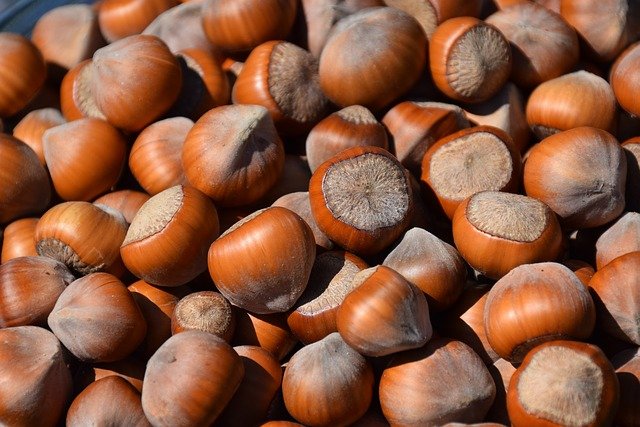
Hazelnut oil, extracted from the seeds of the Corylus avellanaplant, is rich in vegetable fats excellent for the high presence of omega 3, useful for preventing cardiovascular diseases and lowering cholesterol or in the blood.
Characteristics of hazelnut oil
Hazelnut oil is extracted from the seeds of the hazel, Corylus avellana, a common bush in Italian woods. In fact, its presence makes it appreciate its oily dried fruits since ancient times and dates back to the Bronze Age its cultivation for the properties and edible use of hazelnuts.
Hazelnut oil is extracted by mechanical cold pressing with separation of the oily part from the creamier one and this process allows to maintain all its organoleptic properties.
The taste of hazelnut oil is very pleasant and the scent is delicately fruity. The oil is amber yellow in color and is considered a light oil, used both for food purposes and for the preparation of natural cosmetic products.
Properties and use of hazelnut oil
Its composition is rich in vegetable fats excellent for the high presence of the precious omega 3 that are useful to prevent cardiovascular diseases and help lower cholesterol or in the blood.
A recent study has shown that regular use of hazelnuts and hazelnut oil is able to lower LDL cholesterol and triglyceride levels.
Hazelnut oil is rich in vitamin E, an antioxidant that fights free radicals particularly suitable for both children and the elderly.
Its composition of vitamins seesa wide range of vitamins of group B: B6, B1, B2 and also vitamin A and PP.
Hazelnut oil is a source of precious minerals such as selenium which has properties capable of slowing down cellular aging. It is also a good source of calcium,to be recommended to strengthen the skeletal system, hair and nails.
It contains flavonoids, especially of the polyphenol group that possess an anti-inflammatory, antiviral and preventive action of seasonal malaise up to the reduction of the onset of some types of tumors.
Finally, there are phytosterols, plant substances with preventive action against cardiovascular diseases.
In the kitchen hazelnut oil is particularly sought after in high-class catering to flavor mixed salads, including fruit salads and crudités in general.
In addition, hazelnut oil is appreciated in the preparation of sweets,cakes and biscuits, replacing butter or margarine, thanks to its ability to withstand cooking well. It can accompany ice cream, sweet crepes, muesli and mixed fruit in fruit salad. For health it is able to promote cell regeneration and stimulates circulation.
Used daily in the diet it is nutritious, remineralizing and energetic so it is also recommended in periods of fatigue and to help rebalance during convalescence. For beauty and in the field of natural cosmetics, hazelnut oil is used directly for the care of the skin of the face being sweet, nourishing and regenerating on epithelial cells and finally also moisturizing for the whole body.
The direct treatment can also be applied in case of skin irritation, on sensitive and dry skin, in case of eczema and erythema even of children; this is thanks to its composition that has anti-inflammatory properties and manages to give flexibility and elasticity to the skin even after a few applications of topical use.
One of its excellent features is penetrability,which is very rapid and goes deep until it acts on wrinkles, stretch marks and scars; this characteristic is used in cosmetic treatments by inserting it as an essential ingredient for face and body creams and lotions.
For those prone to acne, hazelnut oil comes to the rescue because it is able to regulate the secretion of sebum of the oiliest areas of the face, frees the pores and thus removes the formation of black spots, and finally has an astringent and toning action that definitively rebalances the skin.
The use of the oil as a lotion on the hair through compresses of at least 30 minutes allows you to restore tone to the hair fiber and also purify the scalp.
Hazelnut oil in addition to being absorbed quickly has another advantage: it is not greasy. This allows an advantageous use as a base for massage oil and as a night cream to keep for the entire hours of sleep and wake up with a fairytale and more toned skin.
Did you know that
During the mid-twentieth century with the situation of instability and difficulty of the war some farmers who could no longer find olive oil began to produce hazelnut oil directly at home handcrafted for food use.
This use in some geographical areas rich in the presence of hazelnuts led in the popular tradition to include hazelnut oil in the recipes of typical local dishes.
A recipe
Getting homemade hazelnut oil is not that difficult. As ingredients serve hazelnuts of good quality, untreated and possibly with the shell.
To maintain all the properties and preserve them to the maximum it is recommended to buy the oil seeds in shell and then shell them only at the time of need. Once the hazelnuts are shelled we can put them in a blender or mixer of good power and begin to blend them at high speeds.
Initially we will have the shredding of hazelnuts but with time we will see the oil emerge that will separate from the rest of the chopped mixture. Finally, we will have the oil on the surface and the hazelnut cream below. To divide them it will be enough to separate with a colander and a piece of clean cotton and squeeze away the oily part that will go into a small bottle.
For storage and to avoid or delay rancidity it is necessary to use dark glass bottles, beautiful sealed and kept away from heat sources. Vitamin E should be added as an antioxidant or if we want we can put a sprig of rosemary in the oil but it will condition the flavor.
For food use, if good preservation practices are observed, just taste that the flavor remains unchanged and if we have changes towards rancidity then we finish using hazelnut oil as a topical use for the beauty of the skin in a short time.






